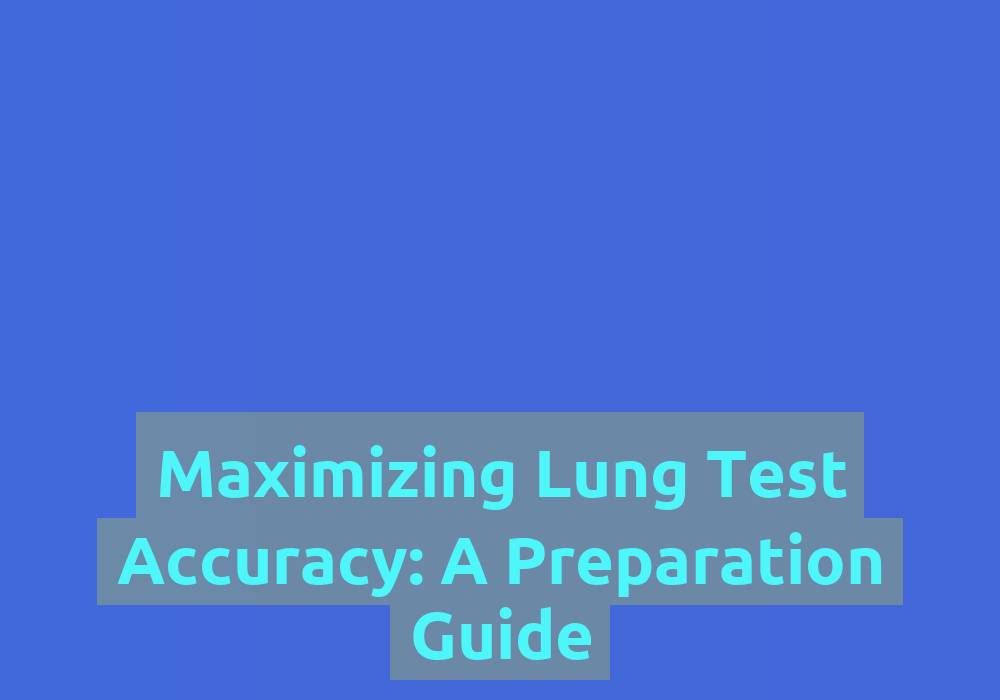Maximizing Lung Test Accuracy: A Preparation Guide

Lung tests are vital diagnostic tools used to assess the health and functioning of our respiratory system. These tests are commonly performed to diagnose various lung conditions such as asthma, chronic obstructive pulmonary disease (COPD), and lung cancer. To ensure accurate results from these tests, it is essential to adequately prepare beforehand. In this comprehensive guide, we will discuss the steps you can take to maximize the accuracy of your lung test results.
Understanding the Importance of Lung Test Accuracy
Accurate lung test results are crucial for an accurate diagnosis and subsequent treatment plan. By maximizing the accuracy of these tests, healthcare professionals can make informed decisions based on reliable data, leading to better patient outcomes. Whether it is a spirometry test, pulmonary function test (PFT), or a bronchoscopy, following the proper preparation guidelines can significantly enhance the accuracy of the results obtained.
Lung tests provide valuable information about the condition of our respiratory system. Accurate results are essential as they serve as the foundation for an accurate diagnosis and the development of an effective treatment plan. By having precise and reliable data, healthcare professionals can make informed decisions that lead to better patient outcomes. For instance, accurate lung test results can help identify the presence and severity of lung conditions such as asthma, COPD, and lung cancer. This information is crucial for determining the appropriate course of treatment and monitoring the effectiveness of interventions.
To ensure accurate lung test results, it is important to carefully prepare before undergoing these tests. By following the proper preparation guidelines, you can optimize the accuracy of the results obtained. This, in turn, facilitates better decision-making by healthcare professionals and ultimately improves patient care. Proper preparation involves considering various factors such as consulting with your healthcare provider, following pre-test instructions, informing your healthcare provider about medications and supplements, avoiding smoking and exposure to respiratory irritants, following dietary restrictions, getting a good night’s sleep, wearing comfortable clothing, arriving early, and staying relaxed.
Preparing for a Lung Test: Step-by-Step Guide
- Consult with Your Healthcare Provider: Before undergoing any lung test, it is essential to consult with your healthcare provider. They will assess your medical history, symptoms, and the purpose of the test to determine the appropriate lung test for your specific needs.
When consulting with your healthcare provider, it is important to provide them with accurate and detailed information about your medical history and symptoms. This information will help them determine the most suitable lung test for your specific needs. By understanding your medical background and the purpose of the test, your healthcare provider can tailor the test to gather the necessary data for an accurate diagnosis. Open and honest communication with your healthcare provider is key to ensuring that the lung test is appropriate and effective.
- Follow Pre-Test Instructions: Your healthcare provider will provide you with specific pre-test instructions that vary depending on the type of lung test you will undergo. It is crucial to follow these instructions carefully to achieve the most accurate results. Some general guidelines may include avoiding certain medications, not smoking before the test, or fasting for a specified period.
Pre-test instructions are designed to optimize the accuracy of your lung test results. These instructions may vary depending on the specific type of lung test you are scheduled to undergo. It is important to carefully follow these instructions to ensure consistent and reliable results. For example, your healthcare provider may advise you to avoid certain medications that could interfere with the test outcome. By adhering to these instructions, you can help eliminate potential confounding factors and obtain accurate data.
- Inform Your Healthcare Provider: Make sure to inform your healthcare provider about any medications or supplements you are currently taking. Certain medications can interfere with lung test results, so it is essential to disclose all relevant information. Your healthcare provider will advise you on which medications to avoid or adjust before the test.
Informing your healthcare provider about all the medications and supplements you are taking is crucial to ensure accurate lung test results. Some medications can affect lung function or interact with the procedures involved in the test. By providing a comprehensive list of your medications and supplements, your healthcare provider can make any necessary adjustments or advise you on which ones to avoid prior to the test. This step is essential for obtaining reliable and accurate results.
- Avoid Smoking and Exposure to Respiratory Irritants: Smoking and exposure to respiratory irritants such as dust, chemicals, or pollutants can significantly impact lung function. It is advisable to refrain from smoking and avoid exposure to these irritants for a specified time before the test. This precaution helps ensure accurate lung test results.
Smoking and exposure to respiratory irritants can have detrimental effects on lung function. These factors can cause inflammation and irritation in the respiratory system, leading to compromised test results. To maximize the accuracy of your lung test, it is important to avoid smoking and exposure to respiratory irritants for a certain period before the test. By doing so, you can help ensure that your lung function is not influenced by these external factors, allowing for more accurate results.
- Follow Dietary Restrictions: Depending on the type of lung test, your healthcare provider may recommend specific dietary restrictions. For example, if you are scheduled for a bronchoscopy, you may need to refrain from eating or drinking for a certain period before the procedure. Adhering to these guidelines is crucial for accurate test results.
Dietary restrictions may be necessary for certain types of lung tests to ensure accurate results. Your healthcare provider will provide specific instructions regarding what you can eat or drink before the test. It is important to follow these guidelines to prevent any interference with the test outcome. By adhering to the recommended dietary restrictions, you can help optimize the accuracy of the lung test results and facilitate a more accurate diagnosis.
- Get a Good Night's Sleep: Adequate rest is vital for optimal lung function. Make sure to get a good night’s sleep before the test to ensure your body is well-rested and ready to perform at its best. Fatigue can affect lung test results, so prioritize rest the night before your appointment.
Getting sufficient sleep before a lung test is essential to ensure optimal lung function. Fatigue can affect breathing patterns and lung capacity, potentially leading to inaccurate test results. By prioritizing a good night’s sleep, you can help ensure that your body is well-rested and capable of performing the necessary breathing maneuvers accurately. This, in turn, contributes to more reliable and accurate lung test results.
- Wear Comfortable Clothing: Comfortable clothing can facilitate ease of movement during the test. Opt for loose-fitting attire that allows unrestricted breathing. This ensures that you can perform the necessary breathing maneuvers accurately, leading to more accurate lung test results.
Choosing comfortable clothing for your lung test is important as it allows for ease of movement and unrestricted breathing. Tight or restrictive clothing can impede your ability to perform the necessary breathing maneuvers accurately, potentially compromising the accuracy of the test results. By wearing loose-fitting attire, you can ensure that your movements are not restricted, facilitating optimal lung function during the test.
- Arrive Early and Stay Relaxed: It is advisable to arrive early for your lung test appointment to complete any necessary paperwork or preparation procedures. Additionally, try to stay relaxed and calm before and during the test. Anxiety and stress can affect breathing patterns, potentially impacting the accuracy of the test results.
Arriving early for your lung test appointment allows you to complete any required paperwork or preparation procedures without feeling rushed or stressed. This helps ensure that you are fully prepared for the test and can focus on the task at hand. It is also important to stay relaxed and calm before and during the test. Anxiety and stress can affect breathing patterns, potentially leading to inaccurate test results. By maintaining a relaxed state, you can help optimize the accuracy of the lung test results.
Common Lung Tests and their Preparation Guidelines
1. Spirometry Test
Spirometry is a commonly performed lung function test that measures the amount of air you can inhale and exhale forcefully. To prepare for a spirometry test:
- Avoid smoking for at least 24 hours before the test.
- Avoid eating heavy meals or drinking excessive liquids before the test.
- Wear comfortable clothing that allows ease of movement during the procedure.
- Follow any additional instructions provided by your healthcare provider.
Preparing for a spirometry test involves specific guidelines to ensure accurate results. Smoking should be avoided for at least 24 hours before the test, as it can affect lung function. Additionally, it is recommended to avoid heavy meals or excessive liquids before the test, as these can impact breathing patterns. Wearing comfortable clothing that allows ease of movement is important to perform the necessary breathing maneuvers accurately. It is crucial to follow any additional instructions provided by your healthcare provider to maximize the accuracy of the spirometry test results.
2. Pulmonary Function Test (PFT)
Pulmonary function tests assess various aspects of lung function, including lung capacity and the ability to breathe effectively. To prepare for a PFT:
- Avoid smoking and exposure to respiratory irritants for at least 24 hours before the test.
- Avoid consuming alcohol or caffeine for at least four hours before the test.
- Follow any medication-related instructions provided by your healthcare provider.
- Wear comfortable clothing that allows unrestricted breathing.
Preparing for a pulmonary function test requires specific considerations to ensure accurate results. It is important to avoid smoking and exposure to respiratory irritants for at least 24 hours before the test, as these factors can affect lung function. It is also advisable to refrain from consuming alcohol or caffeine for at least four hours before the test, as they can influence breathing patterns. Following any medication-related instructions provided by your healthcare provider is crucial to avoid any potential interference with the test outcome. Wearing comfortable clothing that allows unrestricted breathing is essential for accurate testing.
3. Bronchoscopy
Bronchoscopy is a procedure that allows healthcare providers to examine the airways and collect samples for further analysis. To prepare for a bronchoscopy:
- Fast for a specified period before the procedure (as advised by your healthcare provider).
- Follow any medication-related instructions provided by your healthcare provider.
- Arrange transportation to and from the procedure, as sedation may be involved.
- Discuss any specific concerns or allergies with your healthcare provider beforehand.
Preparing for a bronchoscopy involves several important steps to ensure a successful procedure. Fasting for a specific period before the procedure is typically required to ensure clear visualization of the airways. It is important to follow any medication-related instructions provided by your healthcare provider to minimize any potential complications during the procedure. As sedation may be involved, it is necessary to arrange transportation to and from the medical facility. Prior to the procedure, it is crucial to discuss any specific concerns or allergies with your healthcare provider to ensure optimal safety and comfort.
Conclusion
Maximizing the accuracy of lung test results is essential for accurate diagnoses and effective treatment plans. By carefully following the preparation guidelines provided by your healthcare provider, you can ensure reliable data and facilitate better decision-making. Remember to consult with your healthcare provider for personalized instructions and recommendations based on your specific needs. By taking these necessary steps, you can optimize the accuracy of your lung test results and ultimately improve your respiratory health.
In conclusion, proper preparation is crucial for maximizing the accuracy of lung test results. By following the step-by-step guide provided in this article, you can ensure that you are adequately prepared for your lung test. Consulting with your healthcare provider, adhering to pre-test instructions, informing them about your medications, avoiding smoking and exposure to respiratory irritants, following dietary restrictions, getting a good night’s sleep, wearing comfortable clothing, arriving early, and staying relaxed are all important factors to consider. By taking these necessary steps, you can optimize the accuracy of your lung test results and contribute to better respiratory health outcomes. Always remember to consult with your healthcare provider for personalized instructions and recommendations based on your specific needs.
FAQ
- Why is it important to maximize the accuracy of lung test results?
- Accurate lung test results are crucial for an accurate diagnosis and subsequent treatment plan. By maximizing the accuracy of these tests, healthcare professionals can make informed decisions based on reliable data, leading to better patient outcomes.
- What should I do before undergoing a lung test?
- Before undergoing any lung test, it is essential to consult with your healthcare provider. They will assess your medical history, symptoms, and the purpose of the test to determine the appropriate lung test for your specific needs. It is also important to follow pre-test instructions, inform your healthcare provider about any medications or supplements you are taking, avoid smoking and exposure to respiratory irritants, follow dietary restrictions, get a good night’s sleep, wear comfortable clothing, arrive early, and stay relaxed.
- How can I ensure accurate results for a spirometry test?
- To prepare for a spirometry test, it is recommended to avoid smoking for at least 24 hours before the test, avoid eating heavy meals or drinking excessive liquids before the test, wear comfortable clothing that allows ease of movement, and follow any additional instructions provided by your healthcare provider.
- What are the preparation guidelines for a bronchoscopy?
- To prepare for a bronchoscopy, it is necessary to fast for a specified period before the procedure (as advised by your healthcare provider), follow any medication-related instructions provided by your healthcare provider, arrange transportation to and from the procedure, and discuss any specific concerns or allergies with your healthcare provider beforehand.





